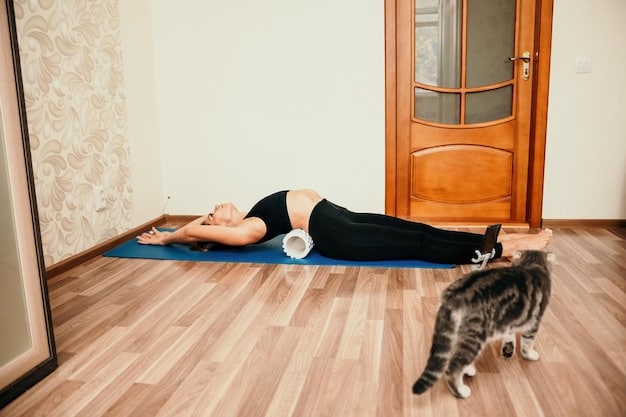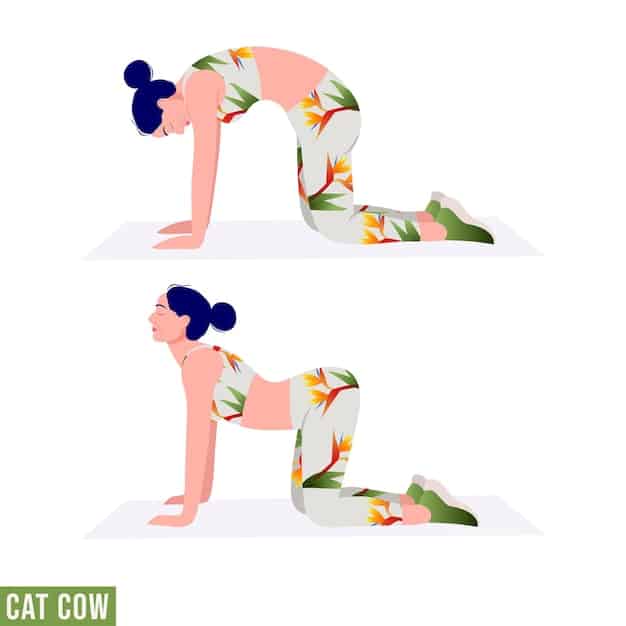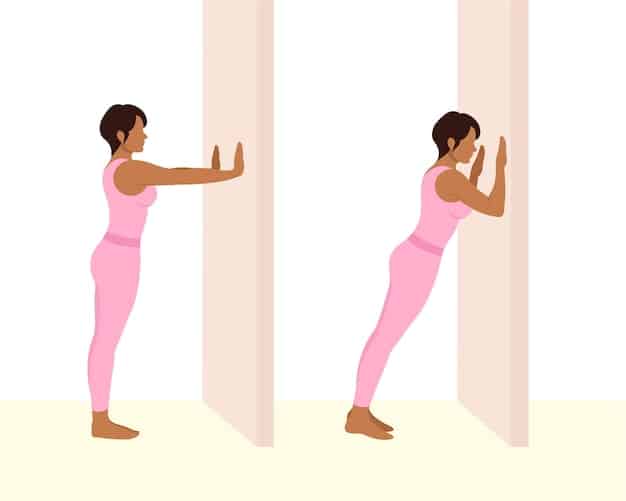5 Easy Home Exercises for Better Posture and Less Back Pain

Five simple exercises, including the cat-cow stretch, pelvic tilts, and planks, can be performed at home to significantly improve your posture and reduce back pain by strengthening core muscles and increasing flexibility.
Do you suffer from back pain and poor posture? You’re not alone. Luckily, five simple exercises you can do at home to improve your posture and reduce back pain can make a significant difference in your comfort and well-being.
Understanding the Importance of Good Posture
Good posture is more than just standing up straight. It involves training your body to stand, walk, sit, and lie in positions that place the least strain on supporting muscles and ligaments during movement and weight-bearing activities. Understanding why it’s important can motivate you to incorporate corrective exercises into your daily routine.
Why Posture Matters
Maintaining correct posture has numerous benefits for your physical and mental health. It reduces the risk of back pain, neck pain, and other musculoskeletal problems.
- Reduces strain on ligaments and muscles.
- Improves breathing capacity.
- Enhances self-confidence and appearance.
Poor posture, on the other hand, can lead to a variety of health issues, including chronic pain, fatigue, and even digestive problems. It’s essential to address and correct it to improve your overall quality of life.
Ultimately, understanding the significance of good posture sets the stage for actively working towards it. Engaging in targeted exercises can help realign your body and alleviate pain, contributing to a healthier and happier you. Prioritizing posture is an investment in your long-term well-being.
Exercise 1: The Cat-Cow Stretch
The cat-cow stretch is a gentle and effective way to improve spinal flexibility and reduce tension in your back and neck. It’s a simple movement that can be easily incorporated into your daily routine.

How to Perform the Cat-Cow Stretch
Follow these steps to perform the cat-cow stretch correctly:
- Start on your hands and knees, with your hands directly under your shoulders and your knees under your hips.
- As you inhale, drop your belly towards the floor, arch your back, and lift your head and tailbone (cow pose).
- As you exhale, round your spine towards the ceiling, tuck your chin to your chest, and tuck your tailbone (cat pose).
- Continue alternating between these two poses for 5-10 minutes, coordinating your breath with your movement.
The cat-cow stretch not only improves spinal mobility but also stimulates the abdominal organs and calms the mind. It’s a great way to start your day or unwind before bed.
Incorporating the cat-cow stretch into your routine is a proactive step towards maintaining a healthy spine and reducing back pain. Its gentle movements make it accessible to people of all ages and fitness levels, making it a foundational exercise for posture improvement.
Exercise 2: Pelvic Tilts
Pelvic tilts are another excellent exercise for strengthening your core muscles and improving posture. They help to stabilize your lower back and reduce pain.
Performing Pelvic Tilts
Here’s how to do pelvic tilts effectively:
- Lie on your back with your knees bent and feet flat on the floor.
- Engage your abdominal muscles and gently tilt your pelvis upwards, pressing your lower back into the floor.
- Hold for a few seconds, then release and tilt your pelvis downwards, creating a small arch in your lower back.
- Repeat this movement for 10-15 repetitions.
Pelvic tilts are a subtle but powerful exercise for improving core stability and reducing lower back pain. They can be done anytime, anywhere, making them a convenient addition to your daily routine.
Consistency is key when it comes to seeing results with pelvic tilts. By making them a regular part of your exercise regimen, you can gradually strengthen your core and improve your posture, leading to a more comfortable and pain-free life.
Exercise 3: The Plank
The plank is a highly effective core-strengthening exercise that can significantly improve your posture and reduce back pain. It engages multiple muscle groups simultaneously, making it a time-efficient workout.
Mastering the Plank
Follow these steps to perform a plank correctly:
- Start in a push-up position, with your hands directly under your shoulders and your body in a straight line from head to heels.
- Engage your core muscles and maintain this position for as long as you can, gradually increasing the duration as you get stronger.
- Avoid sagging your hips or arching your back. Keep your body in a straight line throughout the exercise.
The plank is a challenging exercise, but the benefits are well worth the effort. It strengthens your core, improves your posture, and reduces your risk of back pain.
Gradually increasing the duration of your plank holds will lead to noticeable improvements in your core strength and overall posture. As you become more proficient, you’ll find that you can maintain the correct form for longer periods, maximizing the benefits of this powerful exercise.
Exercise 4: Chest Stretches
Chest stretches are essential for counteracting the effects of prolonged sitting and poor posture, which often lead to rounded shoulders and a tight chest. These stretches help to open up your chest, improve your posture, and reduce upper back pain.
Simple Chest Stretch Techniques
Here are a couple of chest stretches you can easily do at home:
- **Doorway Stretch:** Stand in an open doorway and place your forearms on the doorframe, with your elbows at shoulder height. Gently lean forward until you feel a stretch in your chest. Hold for 20-30 seconds.
- **Corner Stretch:** Stand facing a corner and place your forearms on the walls, with your elbows at shoulder height. Gently lean forward until you feel a stretch in your chest. Hold for 20-30 seconds.
Consistent chest stretching helps to improve your posture by opening up your chest and allowing your shoulders to move back into a more natural position. This can alleviate upper back pain and improve your overall alignment.
Regularly incorporating chest stretches into your routine can reverse the negative effects of prolonged sitting and poor posture. By opening up your chest and improving your shoulder alignment, you’ll experience increased comfort and reduced pain in your upper back and neck.

Exercise 5: Shoulder Blade Squeeze
Shoulder blade squeezes, also known as scapular retractions, are a simple yet effective exercise for improving posture and strengthening the muscles in your upper back. They help to counteract rounded shoulders and promote better spinal alignment.
Performing Shoulder Blade Squeezes Correctly
Follow these steps to do shoulder blade squeezes effectively:
- Sit or stand with good posture, your shoulders relaxed.
- Gently squeeze your shoulder blades together, as if you’re trying to hold a pencil between them.
- Hold for a few seconds, then release.
- Repeat this movement for 10-15 repetitions.
Shoulder blade squeezes are a great way to strengthen the muscles that support your upper back and promote better posture. They can be done anytime, anywhere, making them a convenient addition to your daily routine.
By consistently performing shoulder blade squeezes, you can strengthen your upper back muscles and improve your posture over time. This exercise can help to alleviate neck pain, shoulder pain, and upper back pain associated with poor posture.
| Key Exercise | Brief Description |
|---|---|
| 🧘 Cat-Cow Stretch | Gentle spinal movement to increase flexibility and reduce tension. |
| 🍑 Pelvic Tilts | Core exercise to stabilize lower back and reduce pain. |
| 💪 Plank | Core strengthening exercise for posture and back pain reduction. |
| 🧍 Shoulder Blade Squeeze | Strengthens the upper back muscles and improves the posture. |
FAQ Section
Aim to perform these exercises daily or at least 3-5 times per week for optimal results. Consistency is key to improving posture and reducing back pain.
These exercises can significantly alleviate back pain and improve posture. However, if you have chronic or severe pain, consult a healthcare professional first.
Some of these exercises, like pelvic tilts, can be beneficial during pregnancy. However, consult your doctor before starting any new exercise routine during pregnancy.
Results vary from person to person, but with consistent effort, you may start to notice improvements in your posture and a reduction in back pain within a few weeks.
If you have any pre-existing medical conditions, such as arthritis or spinal stenosis, consult your doctor before starting these exercises to ensure they are safe for you.
Conclusion
Incorporating these five simple exercises you can do at home to improve your posture and reduce back pain into your daily routine can significantly enhance your comfort, well-being, and overall quality of life. Remember to listen to your body, stay consistent, and consult a healthcare professional if you have any concerns or pre-existing conditions.





